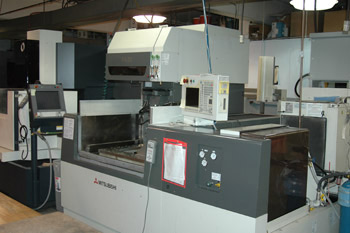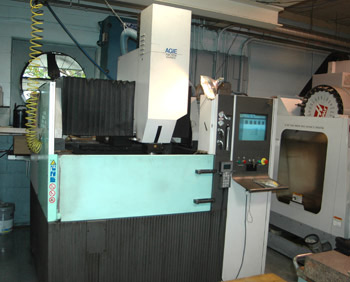EDM
Production

EDM - Electrical Discharge Machining is a machining method primarily used for hard metals or those that would be impossible to machine with traditional techniques.
One critical limitation, however, is that EDM only works with materials that are electrically conductive, such as hardened tool-steel, titanium, and carbide.
EDM is the perfect tool for intricate contours or and cavities that would be difficult to produce with other cutting tools. It is also used for quality control and inspecting internal cavities once the part is produced.
There are two primary EDM methods: ram EDM and wire EDM. The difference between the two involves the electrode that is used to perform the machining.
RAM EDM

A graphite electrode is machined with traditional tools in our shop. The now specially-shaped electrode is connected to the power source, attached to a ram, and slowly fed into the workpiece. The entire machining operation is usually performed while submerged in a fluid bath. The fluid flushes material away, acts as a coolant, and acts as a conductor for the current to pass between the electrode and the workpiece. This allows a wide variety of cavities to be created.
Wire EDM
In wire EDM a very thin wire serves as the electrode. Special brass wires are typically used; the wire is slowly fed through the material and the electrical discharges actually cut the workpiece. Wire EDM is usually performed in a bath of water. The computer controlled path allows extremely complex shapes to be produced.
